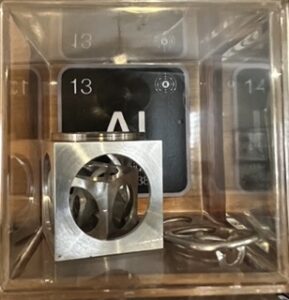Aluminium
Atomic Number: 13
Atomic Mass: 26.981539 u

Aluminium, the most abundant metal in the Earth’s crust, is an element that has fundamentally transformed various industries with its unique properties. Recognized for its light weight, strength, and resistance to corrosion, it plays a pivotal role in modern society. This article delves into the various uses of aluminium and its significance in today’s world.
A Glimpse into History
Aluminium was first isolated in 1825 by Danish physicist Hans Christian Ørsted. However, it wasn’t until the late 19th century that an efficient method for its extraction was developed, making it more accessible. Initially more valuable than gold, its status has dramatically changed, becoming a common yet vital metal.
Ubiquitous Use in Everyday Life
1. Transportation Industry
One of the most significant uses of aluminium is in the transportation industry. Its light weight, coupled with high strength, makes it ideal for aircraft, vehicles, and ships, significantly improving fuel efficiency.
2. Construction and Infrastructure
In the construction sector, it is valued for its durability and resistance to corrosion. It’s used in windows, doors, roofing, and structural frames. Its reflective property also makes it useful in insulation.
3. Packaging Material
Aluminium is widely used in packaging. Think of soft drink cans, foil wrappers, and food containers. Its impermeability to air and light helps preserve food and beverages.
4. Electronics and Appliances
In electronics, it is used in mobile phones, computers, and other gadgets due to its excellent conductivity and shielding properties. It’s also found in large home appliances like refrigerators and washing machines.
5. Power Lines
Aluminium is a key material in power lines across the globe. Its conductivity, combined with its light weight, makes it a more practical and economical choice than copper.
Environmental Impact and Recycling
A notable aspect of aluminium is its recyclability. It can be recycled indefinitely without losing its properties, making it a champion of sustainable practices. Recycling it saves 95% of the energy required to produce it from raw materials, significantly reducing its environmental footprint.
Aluminium in Art and Design
Beyond its functional uses, it has made its mark in art and design. Its sleek, modern aesthetic is favored in furniture, sculptures, and architectural design. Its malleability allows artists and designers to push the boundaries of creativity.
Future Prospects
Looking ahead, aluminium’s role in emerging technologies is promising. It’s a critical component in electric vehicles and renewable energy systems, like solar panels and wind turbines. As we move towards a more sustainable future, the demand for it is expected to rise, driven by its eco-friendly and energy-efficient characteristics.
Conclusion
From its once-precious status to becoming an everyday essential, aluminium’s journey is a testament to human ingenuity and adaptation. This lightweight yet sturdy metal continues to shape our world, from the vehicles we drive to the way we package our food. As we continue to explore its potential, aluminium stands out as a key element in driving innovation and sustainability in the 21st century.
For Kids
- Super Light Superhero: Aluminium is super lightweight! It’s actually about three times lighter than iron, which is why it’s used to make airplanes and bicycles. Imagine if bikes were made of a heavier metal – riding them would be a tough workout!
- Wrap It Up: You’ve probably seen aluminium foil in the kitchen. It’s great for wrapping up food because it doesn’t rust and doesn’t react with the food. Plus, it can be recycled and used again!
- Out of This World: Aluminium isn’t just found on Earth – it’s also in outer space! It’s one of the most common metals in the Milky Way galaxy.
- Can Do Attitude: Lots of soda cans are made of aluminium. It’s estimated that millions of aluminium cans are used every day around the world!
- Shiny and Dull: Aluminium is a very shiny metal, but it quickly reacts with air to form a dull coating. This coating actually protects it from rusting.
- Bend, Don’t Break: Aluminium is really flexible. It can be made into thin sheets or molded into various shapes, making it super useful for all kinds of things.
- Drinks on the Move: The first use of aluminium in drinks cans was back in 1957. Before that, cans were made of tin or steel.
- Recycling Rockstar: Aluminium is one of the most recycled materials. Recycling aluminium saves 95% of the energy needed to make new aluminium from raw materials.
- Green Metal: Because it’s so recyclable and durable, aluminium is considered an environmentally friendly metal.
- A Hidden Element: Although aluminium is the most abundant metal in the Earth’s crust, it’s never found in its pure form in nature. It’s always mixed with other elements.
Remember, while aluminium might seem ordinary because we see it in everyday items, it’s actually a pretty amazing and versatile metal! 🌟🚲🌌🥫🍔🌍🔄🌿🔍
 using WordPress and
using WordPress and
No responses yet